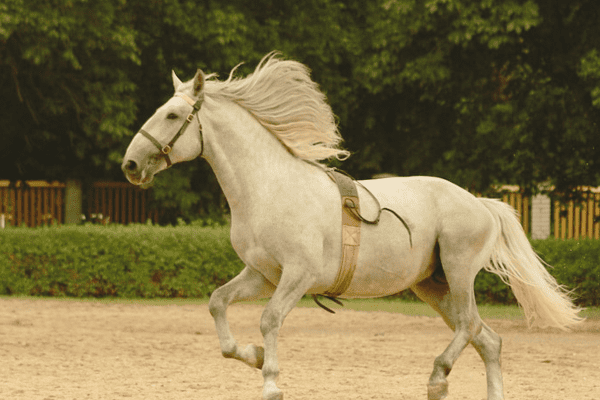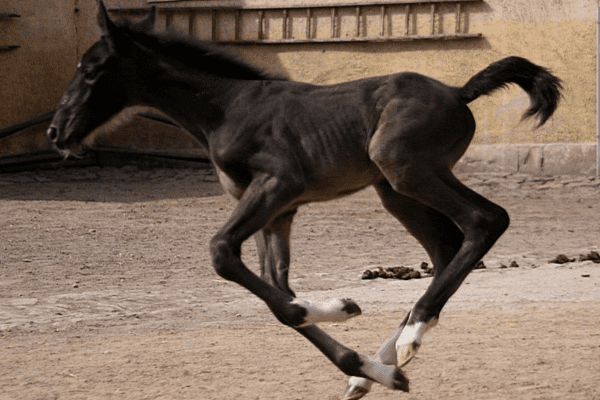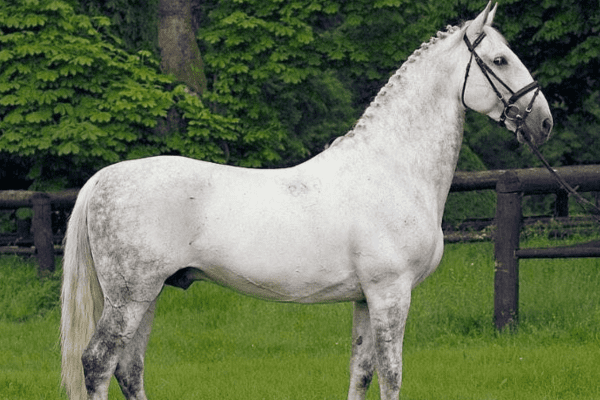The Kladruber, renowned for its distinguished history, emerges as the Czech Republic’s most ancient horse breed and one of the oldest in the world. Its origins, dating back to the 16th and 17th centuries, reveal a rich genetic tapestry woven from the finest old Spanish and Italian equine lines, akin to its cousin, the Lipizzan Horse. This breed’s rarity and unique lineage underscore its significant role in equestrian heritage, marking it as a living embodiment of equine elegance and historical depth.
History:
The Kladruber horse, an icon of equine history and rarity, dates back almost 400 years to its roots at Kladruby nad Labem Stud in Czechia. Over this time period it has proven both its resilience and human influence on its development – here is more of its rich history.
Founding of Kladruby Stud: Emperor Rudolf II founded the Kladruby nad Labem Stud at Pernstein stables, marking its creation and creating an important moment in breeding history. This stud eventually evolved into being known as Kladruber breed.
Genetic Blend and Purpose: The Kladruber was intentionally developed as an amalgamation of Spanish and Italian horses, featuring bloodlines from Neapolitan, Danish, Holstein Irish Oldenburg breeds in addition to heavy Czech breeds. This complex combination was intended to produce galakarosier carriage horses to pull imperial coaches during ceremonies or funerals.
Color History: Kladrubers were initially known to display a wide array of coat colors, from palomino and appaloosa to gray or black; however, breeding programs later focused on producing exclusively gray or black horses to meet court ceremonies’ specific requirements.
Historical Challenges and Relocations: The Kladruber was not without its share of hardship in its long history. For example, during the Seven Years’ War it had to relocate temporarily between Kopcany, Slovakia and Enyed, Hungary during an evacuation order issued during that conflict. Furthermore, an unfortunate fire at Kopcany in 1757 claimed many early breeding records which caused irreparable harm to its history.
Influential Stallions and Lineages:
Pepoli: Pepoli was a gray stallion who sired Generale in Kopcany in 1787; Generale is considered an ancestor to all current gray Kladrubers.
Maestoso and Favory: Both born at Kladruby Stud Farm, these Lipizzan stallions became cornerstones for Lipizzan stallion lineages; Favory was even brought back after World War II to rejuvenate his herd.
Barzoi and Legion: Orlov Trotters that contributed significantly to the breed between World Wars I and II. Rudolfo: A Lusitano stallion from Portugal that contributed new genetics post World War II.
The Black Kladruber: This lineage can be distinguished by more Neapolitan influence and their distinctive physical features such as heavy bodies with more distinct physical traits. Sacramoso and Napoleone were prominent stallions within this lineage.
Preservation and Revival Efforts: Despite facing various threats – such as nearly losing the Kladruber herd during the 1930s – preservation efforts have continued, particularly at Slatinany Stud and The Research Institute for Horse Breeding.
In 2019, Kladruby Stud Farm earned recognition from UNESCO, acknowledging its historical and cultural importance for equestrian practice development.
From its inception, the Kladruber horse has served as more than just a breed; it has also served as a living document of history, product of selective breeding efforts and symbol of our connection to horses. From royal processions to modern preservation efforts, its history speaks of adaptability, elegance and lasting significance in the world of equine breeds.


Versatality & Cultural Significance
The Kladruber’s strength and endurance make him a versatile breed, capable of pulling stately carriages just as effectively as working in agricultural settings or participating in competitive driving events. This adaptability speaks volumes about his breed’s carefully managed genetic heritage.
Recently, the Kladruber horse breed has gained international acclaim as a cultural treasure. At its birthplace of Kladruby nad Labem since 16th century, its breeding center serves not only as breeding center but as living museum showcasing rich history and legacy of these magnificent horses. Recently it was even honored with induction onto UNESCO World Heritage List cementing Kladrubers as global equine icons.
Timeline for the Imperial stud farm Kladruby nad Labem, with updated content for each historical event:
| Year | Event |
| 1491 | Acquisition of Pardubice estate by the Pernstein family, including the Kladruby game park |
| 1560 | Maximilian II receives the Pardubice estate, incorporating Kladruby game park, from the Czech estates |
| 1562 | Maximilian II, Holy Roman Emperor, is reported to have established a Spanish horse breeding operation in Kladruby |
| 1579 | Emperor Rudolf II elevates the Kladruby stud to the status of Imperial Court Stud Farm |
| 1757 | Destructive fire at the stud farm leads to the loss of important studbook documents |
| 1770 | Reconstruction of the stud farm initiated by Emperor Joseph II |
| 1764 | Birth of Pepoli, the foundational stallion for the grey Kladruber variety |
| 1787 | Birth of Generale, a significant grey stallion in the Kladruber lineage |
| 1797 | Generale’s offspring, Generalissimus, another influential grey stallion, is born |
| 1800 | Sacramoso, a pivotal black stallion in Kladruber history, is foaled |
| 1844 | Construction of new stables in the Empire architectural style |
| 1918 | Transition of the stud farm’s management to the newly formed nation of Czechoslovakia |
| 1922 | Extinction of the Napoleone lineage within the Kladruber breed |
| 1994 | Royal Court of Denmark adopts Kladrubers as the ceremonial horse breed |
| 1995 | Official recognition of the Kladruber breed as Czech Cultural Heritage |
| 2002 | Designation of the Kladruby stud farm and its core herd of grey Kladrubers as Czech National Cultural Heritage |
| 2005 | Inauguration of Kladrubers for ceremonial duties at the Swedish Royal Court and by Swedish mounted police |


Breed Characteristics:
The Kladruber horse stands as an epitome of grace and versatility on horseback. Here we explore its special attributes which define this noble breed:
Color and Size:
Modern Kladrubers tend to be grey in color, adding to their majestic appearance. Their size ranges between 16.2-17 hands high (approximately 66-68 inches or 173 cm), exuding both strength and stature.
Harness and Draft Use:
Kladrubers are ideal horses for harness work as well as light draft work in agricultural settings, with their strong physical build and temperament making them the perfect combination of power and finesse for these tasks.
Competive Equestrian Sports:
Kladruber horses excel in combined driving competitions organized by Federation Equestre Internationale (FEI). This discipline requires calmness, endurance, and speed from participants – qualities inherent to Kladrubers themselves. Their performance at these events demonstrates their agility and training responsiveness.
Crossbreeding for Riding:
Kladrubers can also be crossbred with lighter breeds to produce horses better suited for dressage riding – these crosses combine their strengths with agility and grace of lighter breeds to produce hybrid horses more suitable for riding than their original breed would allow.
Distinct Physical Traits:
The Kladruber can be recognized by its distinctive physical traits due to years of selective breeding. These include:
Facial Features: They tend to exhibit a prominent Roman or convex facial profile inherited from their Baroque ancestors.
Body Structure: Kladruber horses boast a relatively upright shoulder, pasterns, hooves and long back with short croups – ideal traits for driving horses as they enable high-stepping gaits. While not ideal as riding horses, their unique build has contributed significantly to Kladrubers being excellent driving partners.
Neck and Ancestry: Their high, powerful neck is an eye-catching feature evoking their Spanish-Neapolitan lineage; not only does this trait add visual interest to their harness appearance, but it also speaks volumes about their noble heritage.
Build and Gait:
The Kladruber has an elegant profile, featuring a deep chest with robust legs featuring large joints and hooves designed for endurance and strength. Their robust bodies, however, do not exhibit feathered legs due to their substantial build. Rather, this breed leans more towards lean than fleshy proportions for added elegance in profile.
Movement Characteristics: Kladruber dogs are well known for their high-action, elastic gaits. In particular, their trot is distinguished by a clear cadence and high lift; displaying agility and grace.

